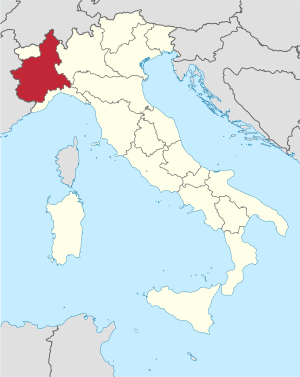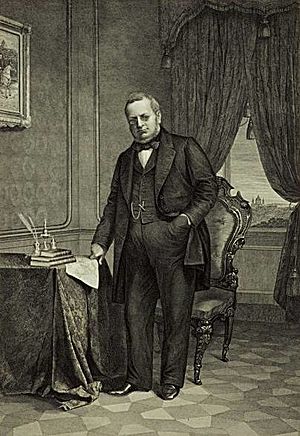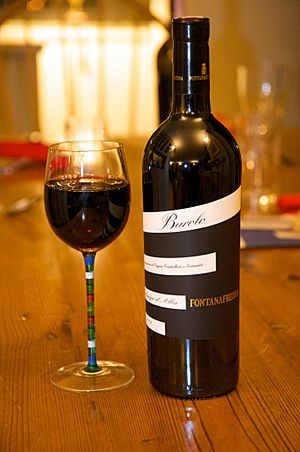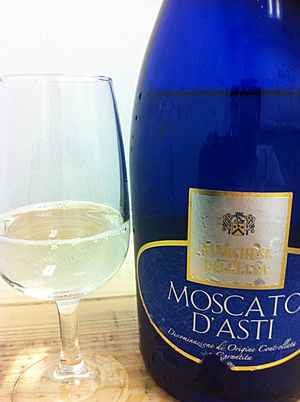Piemonte (wine) facts for kids
Piemonte wine comes from the Piedmont region in the northwest corner of Italy. This area is famous for making some of Italy's best wines. The most well-known wines are Barolo and Barbaresco. They are made from a special grape called Nebbiolo. These wines can be kept for a long time, and as they get older, their color changes to a brownish-red.
Other popular grapes for red wine are Barbera and Dolcetto. Wines made with the Barbera grape are often fruity and a bit tart. They are usually lighter than Nebbiolo wines. The name Dolcetto means "little sweet one" in Italian, but the wine itself is not sweet! It makes fresh, dry red wines that are best enjoyed when they are young.
For sparkling wines, there's Asti spumante, which is made from the Moscato grape. Another grape, Brachetto, is used to make sweet, sparkling red wines. Most of the winemaking happens in the areas around Cuneo, Asti, and Alessandria. While Turin is the capital, Alba and Asti are the main centers for wine.
The wine industry in Piedmont was very important during the Risorgimento, which was when Italy became one country. Important people like Camillo Benso and Giuseppe Garibaldi owned vineyards here. They helped improve the wines. High taxes on Piedmont wines by the Austrian Empire even helped start some of the big changes in Italy around 1848.
Contents
A Look at Wine History in Piedmont
Like many parts of Italy, Piedmont has a long history of growing grapes. The Ancient Greeks even called Italy "Oenotrua," meaning "land of vines." Later, the Romans continued growing grapes here. Because Piedmont is close to France, French winemaking styles, especially from Burgundy, have influenced the region. This is why many Piedmont wines are made from a single type of grape, rather than mixing many.
In the 14th century, a writer named Pietro de Crescentius wrote about Piedmont wines. He mentioned that people tried to make sweet wines by letting grapes dry on the vine. He also noted that vines were being grown closer to the ground, not high up in trees as was common then. In the 17th century, a special pale red wine called Chiaretto, made from Nebbiolo grapes, became very famous.
Wine's Role in Uniting Italy
During the Risorgimento in the 1800s, many winemakers and vineyard owners from Piedmont played a big part. Giuseppe Garibaldi, a famous Italian hero, was a winemaker. In the 1850s, he helped introduce a special spray to fight a plant disease that was harming vineyards. Camillo Benso, a rich vineyard owner, studied advanced grape growing techniques in France. He helped bring many French methods to Piedmont.
One of the reasons for the Italian revolts against Austria was that the Austrian government doubled the taxes on Piedmont wines. This hurt the wine industry a lot, cutting them off from their main markets. In 1846, King Charles Albert of Sardinia spoke out against this unfair treatment. By 1848, Piedmont was at war with Austria, which was an early step towards Italy becoming a united country.
Piedmont's Climate and Geography
The Piedmont region is at the base of the Alps mountains, which form its border with France and Switzerland. To the east is Lombardy, and to the south is Liguria, along the Apennines mountains. A large part of the region is taken up by mountains and the Po Valley, leaving only about 30% of the land suitable for vineyards.
The mountains and valley create a lot of fog in the area. This fog helps the Nebbiolo grape ripen, and the grape's name actually comes from the Piedmontese word nebia, meaning "fog." Even though Piedmont and Bordeaux in France are at similar distances from the equator, Piedmont has colder winters and less rain because the Alps block the clouds. Vineyards are usually planted on hillsides between 490 and 1150 feet high. Warmer, south-facing slopes are used for Nebbiolo or Barbera, while cooler spots are for Dolcetto or Moscato.
Main Wine Regions of Piedmont
Most of the winemaking (about 90%) happens in the southern part of Piedmont, near the towns of Alba (in Cuneo), Asti, and Alessandria.
The Piedmont wine region is divided into five main areas:
- Canavese - This includes areas around Turin, like Carema and Caluso.
- Colline Novaresi - Found in the Novara province.
- Coste della Sesia - This area is around Vercelli.
- Langhe - This is the hilly area around Alba and the Roero.
- Monferrato - Includes the areas around Asti and Alessandria.
Special Wine Classifications: DOC and DOCG
Piedmont has many special wine classifications. There are 41 Denominazione di origine controllata (DOC) and 18 Denominazione di Origine Controllata e Garantita (DOCG) wines. These labels mean the wines meet strict rules about where and how they are made.
The 18 DOCG wines in Piedmont are:
- Alta Langa
- Asti
- Barbaresco
- Barbera d'Asti
- Barbera del Monferrato Superiore
- Barolo
- Brachetto d'Acqui, also called Acqui
- Ruchè di Castagnole Monferrato
- Cortese di Gavi, also simply called Gavi
- Dolcetto di Dogliani Superiore, also simply called Dogliani
- Dolcetto di Ovada Superiore, also simply called Ovada
- Dolcetto di Diano d'Alba, also simply called Diano d'Alba
- Erbaluce di Caluso, also simply called Caluso
- Gattinara
- Ghemme
- Nizza
- Roero, and Roero Arneis
- Terre Alfieri
Grapes and Wines of Piedmont
The Barbera grape is the most common grape grown in Piedmont. However, Nebbiolo and Dolcetto grapes also make a lot of the region's red wines. For white wines, Moscato is the most important, used for sparkling and slightly fizzy wines. Other notable white wines come from the Cortese grape in Gavi, and blends of Cortese with Arneis and Favorita.
Since the 1980s, some winemakers have also been experimenting with international grapes like Cabernet Sauvignon, Chardonnay, Merlot, and Pinot noir. Piedmont makes more DOCG wines than any other Italian wine region. About 84% of all wine produced here has a DOCG label.
Some wines are named after both the grape and the town where they are made. For example, Barbera d'Alba and Dolcetto di Dogliani are made entirely from the Barbera and Dolcetto grapes, respectively.
Barolo: The King of Wines
In 1980, Barolo wines were among the first in Italy to get the special DOCG status. Barolo is made from the Nebbiolo grape and is known for being a big, strong red wine. It comes from the hills southwest of Alba. The soil here is made of clay and marl, which helps balance the grape's natural tartness. The Tanaro river helps keep the summer heat down until harvest time in late October or mid-November.
Barolo is a small wine region, about 7 miles long and 5 miles wide. It produces about 500,000 cases of wine each year. Most of this wine comes from vineyards in five towns: Barolo, Castiglione Falletto, La Morra, Monforte d'Alba, and Serralunga d'Alba. Wines from La Morra and Barolo tend to be very fragrant and smooth, with fewer strong flavors. Wines from Serralunga Valley are fuller and stronger, needing 12–15 years to age before they are at their best.
Barbaresco: The Queen of Wines
Barbaresco wines are made from the same Nebbiolo grape as Barolo and are grown less than 10 miles away. They share many similarities, but the Tanaro river's influence helps create slightly different wines. Barbaresco wines are generally less strong and can be enjoyed sooner than Barolo.
Barbaresco DOCG rules say the wines must have at least 12.5% alcohol and age for at least 2 years in the winery (4 years for riservas). This region is even smaller than Barolo, producing just over 200,000 cases each year. Most Barbaresco comes from three towns: Barbaresco, Treiso, and Neive. The soil in Barbaresco is more consistent, which means the wines tend to have a more uniform taste than the varied Barolo wines.
Moscato d'Asti: Sweet and Bubbly
The white wines made from the Moscato Bianco grape are famous for their bubbly spumante and slightly fizzy frizzante styles. Some still wines are also made. These wines come from the Asti region, northeast of Alba. They are known for being light, low in alcohol, and a little sweet. Like many sparkling wines, Asti wines usually don't have a specific year on the label. They are best enjoyed within 1 to 2 years after they are released.
Other Interesting Wines
The Barbera grape is the most planted grape in Piedmont. It makes a juicy, strong red wine that is not as strong as Barolo and Barbaresco. It grows in almost every wine region in Piedmont, but it does especially well in the southern part of Asti, in the Nizza zone. Some winemakers are even mixing Barbera with Nebbiolo to combine Barbera's fruitiness with Nebbiolo's strong structure.
Wines from the Dolcetto grape are light and fruity. Some people compare them to Beaujolais wines from France. They have a bit of spice, with low tartness and strong flavors. They can be drunk relatively young and are often the everyday wines for people in Piedmont.
Until the 1980s, the white wines from the Gavi region were considered the best dry Italian white wines. Made mostly from the Cortese grape, these wines are known for being dry, crisp, and having flavors of citrus and minerals. The white wines made from the Arneis grape are usually dry, lively, and full-bodied, with flavors of pears and apricots. Arneis wines are made in the hills of the Roero, northwest of Alba. The name Arneis means "rascal" in Piedmontese!








